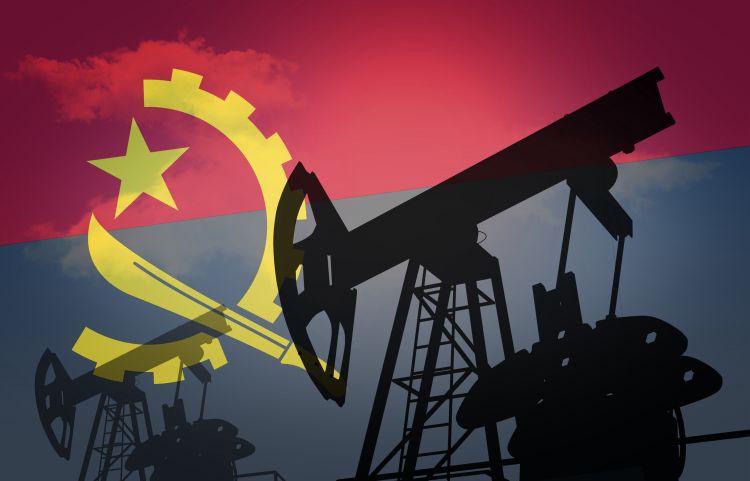Key takeaways
-
- Angola imports 70% of its fuel due to a mismatch between refinery output and domestic consumption.
- Fuel subsidies became fiscally unsustainable as rising demand, a weaker kwanza, and higher global oil prices pushed Angola’s fuel import bill above $3 billion annually.
- Declining oil reserves and production threaten fiscal stability – reserves have shrunk, and output has fallen nearly 40% from peak levels, undermining revenues.
- Subsidy removal is economically necessary but politically risky – a compressed two-year reform timeline risks social backlash.
Refining and consumption
Angola’s operating refinery assets have a total nameplate capacity of 80 Mbpd (thousand barrels of oil per day), which consists of the 65 Mbpd Luanda hydroskimming refinery built in 1958, and the 15 Mbpd Cabinda Gulf Oil Company Limited (CABGOC) Malongo topping plant. The Malongo plant processes crude oil into essential fuels such as diesel, jet fuel, and kerosene.
Although domestic refining capacity expanded from 1980, this capacity has increasingly been under-utilized in favour of oil exports. Between 1980 and 2024, Angola’s exports as a share of its oil production rose from 80% to 97%, this as the national refinery capacity expanded from 30 Mbpd in 1980 to its current 80 Mbpd. Overall, domestic refining capacity utilization has averaged 62% since 1980.

Figure 1 – Angola’s refinery throughput and oil export ratio.
Domestically sourced refined product includes output from the Luanda refinery and Sonangol–purchased products from the CABGOC Malongo topping plant. These domestic sources of refined products have not been sufficient to meet the increasing demand for refined products, which reached 125 Mbpd (5.82 MMtpa) in 2024. In fact, since 2018, the refinery has been processing a declining quantity of crude oil – from 52 Mbpd to just under 40 Mbpd in 2024. This has meant a decline in domestic supply, just as the demand for refined petroleum products has been on the rise. Figure 2 captures this dynamic from 1990 on a per-capita basis.

Figure 2 – Angola’s refined product consumption exceeds its domestic product supply.
The widening deficit between domestic fuel supply and refined product demand has been met by imports surging from 73 Mbpd (3.65 MMtpa) in 2019 to 105 Mbpd (5.23 MMtpa) in 2024. Figure 2 shows that in 2024 for every 1.69 barrels of refined product consumed per person in Angola, 1.16 barrels were imported – a 70% import dependence. As fuel demand rose with oil price – while domestic currency weakened – import expenditures increased.
Since 2015, the kwanza required to purchase one U.S. dollar has increased by 628% as depicted in Figure 3. Consequently, the fuel import bill not only experienced upward pressure from rising consumption and oil price but rose in local currency due to the increasingly weak kwanza.

Figure 3 – The Angolan kwanza to USD exchange rate since August 2015. (Source: xe.com)
According to the observatory for economic complexity (OEC), Angola imported $3.38 billion worth of refined petroleum products in 2023 – 53% of which was from Asia, led by South Korea, UAE, and then India. In 2014, the value of refined product import stood at $1.53 billion – 83% of which was from Asia – led by Singapore, Malaysia, and South Korea. In 2000, Angola’s imports were even lower – at $88.2 million, with 60% from Africa, led by Cameroon, South Africa, and Côte d’Ivoire, in that order.
Refining mismatches – why Angola imports most of its fuel
While the country’s refinery utilization declined, its import dependence rose. The capacity utilization was 76% in 2000 and declined to 45% in 2023. During this period, Angola’s imports as a share of its fuel consumed climbed from 10% to 71%. This dynamic is seen in Figure 4. The increase in share of imports only served to increase Angola’s subsidy bill.

Figure 4 – As Angola’s refinery utilization fell, its import dependence increased.
Disaggregating the consumption of fuels in Angola, in comparison to the yield from the domestic refinery reveals that the refinery output is not matched to the demand profile as captured in Table 1. Note that the share of gasoline produced from domestic refining increased from 3% to 26% from 2020 to 2024, due to the upgrades completed in 2022 at the Luanda refinery, although the domestic production of refined fuels fell by half over that same period. Consequently, the share of gasoline produced domestically (26% in 2024) is more aligned with the share of gasoline consumed (23%) than in prior years.
However, this mismatch still exists for other products. Take distillate fuel oil (diesel), for example; in 2024, its share of the domestic refinery’s output was 22%, while its share of fuels consumed in the country is 45%.
| 2015 | 2020 | 2024 | |
| Domestic refinery production profile | |||
| Motor gasoline | 3% | 3% | 26% |
| Jet fuel | 17% | 17% | 18% |
| Kerosene | 2% | 2% | 3% |
| Distillate fuel oil | 26% | 26% | 22% |
| Residual fuel oil | 34% | 34% | 30% |
| Liquefied petroleum gases | 2% | 2% | 0% |
| Other petroleum liquids | 15% | 15% | 1% |
| Total domestic production (Mb/d) | 51.83 | 46.74 | 21.70 |
| Domestic consumption profile | |||
| Motor gasoline | 14% | 20% | 23% |
| Jet fuel | 6% | 3% | 2% |
| Kerosene | 1% | 1% | 0% |
| Distillate fuel oil | 53% | 40% | 45% |
| Residual fuel oil | 15% | 14% | 11% |
| Liquefied petroleum gases | 5% | 16% | 13% |
| Other petroleum liquids | 6% | 7% | 5% |
| Total domestic consumption (Mb/d) | 156.75 | 85.72 | 125.29 |
Table 1 – Mismatch between Angola’s domestic fuels production and consumption.
Conversely, we see that at least 30% of domestic production is residual fuel oil, while fuel oil’s share of fuel consumed in the country ranges from 11% to 15%. If the volume of domestic production matched demand, Angola would be producing at least twice as much fuel oil as it needed. Additionally, producing one-third of a barrel of oil as fuel oil weighs negatively on the country’s refinery economics, given that fuel oil tends to price at a discount to crude oil.
In order to refine more of its crude oil domestically, there are three other refineries under development that will add 360 Mbpd capacity to the operating 80 Mbpd nameplate capacity of Angola’s refining assets. If all goes according to plan, Angola should have 445 Mbpd refining capacity by 2027. However, is Angola’s upstream ready to supply the increased domestic refining capacity?
Upstream decline – oil output and reserves in freefall
Angola, the second-largest oil-producing country in Africa after Nigeria, accounted for 16% of the continent’s total production of 7.29 MMbpd in 2024. As for reserves, it makes up 2% of Africa’s total reserves of 119.36 billion barrels (2024). However, production has been in decline – Angola’s production of 1.18 MMbpd in 2024 was a 37% decline from its peak production of 1.88 MMbpd in 2008. This is not good news for a country where oil sales make up about 60% of government revenue and 95% of its exports.
The influence of the country’s oil production is reflected in its GDP per capita, which rose just as Angola’s production was on the rise. As Angola’s production declined from its 2008 peak, GDP per capita – which had peaked in 2012 at $5,086/person – also declined, by 58% to $2,122/person in 2024.

Figure 5 – Angola’s GDP per capita trends with oil production.
Angola’s oil reserves have also dropped significantly from 9.52 billion bbls in 2016 to 2.55 billion bbls in 2024. The result is that currently Angola’s reserves can last ~ 6 years at the current rate as captured in Table 2.
| Reserve-Production Ratio | 2010 | 2015 | 2020 | 2024 |
| Reserves (MM bbls) | 9,055 | 9,524 | 7,231 | 2,550 |
| Production (Mb/d) | 1,812 | 1,796 | 1,325 | 1,181 |
| R-P index (yrs) | 14 | 15 | 15 | 6 |
Table 2 – Angola’s reserves/production profile (2010 – 2024).
Clearly, even as the government focuses on unburdening itself from the weight of the fuel subsidy, it must contemplate how to increase both production and reserves. Angola’s production has declined by about 2.85% per annum since its peak in 2008. If production continues to decline at this rate, Angola’s production by 2030 will be less than 1 MMb/d.
The path ahead
Given the challenges of a shrinking GDP, the fiscal pressure from supporting fuel subsidies, and declining revenues arising from decreasing oil production, it is evident that the government is determined to pursue the path of full subsidy removal. An added impetus for removing the subsidy is to ensure the upcoming refineries, due to commence operations in 2027, operate profitably without government support.
Several examples from around the world show that removal of energy subsidies is met with stiff opposition from consumers – as illustrated in the first article of this two-part series. This was recognized by the International Monetary Fund (IMF) and motivated the legislation of the phased subsidy withdrawal, with the provision of social safety. This was intended to mitigate the social backlash that would inevitably arise from the subsidy removals. However, the government is executing a two-year implementation schedule for subsidy removal compared to IMF’s projected six-year period. This is hardly enough time to build the robust social safety net required to cushion the harsh effects of subsidy removals.
Angola currently imports 70% of its fuel consumed, but its plans to develop refineries to increase domestic supply of refined petroleum products should significantly reduce this import dependency and cut the import bill. However, it is unlikely that the presence of domestic refineries will translate to lower prices (read “subsidy-era” prices) at the pump. Nigeria’s two-year, post-subsidy removal experience – during which the Dangote refinery came onstream – is a telling lesson.
(Kaase Gbakon, BIG Media Ltd., 2025)


